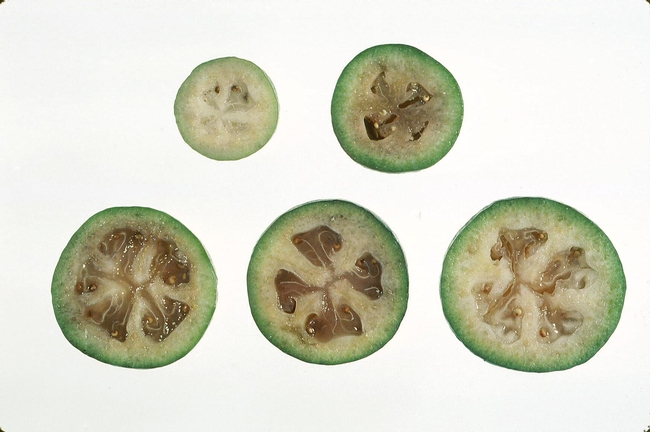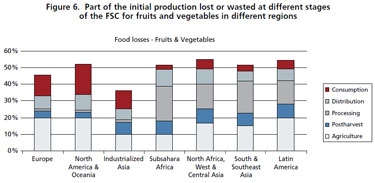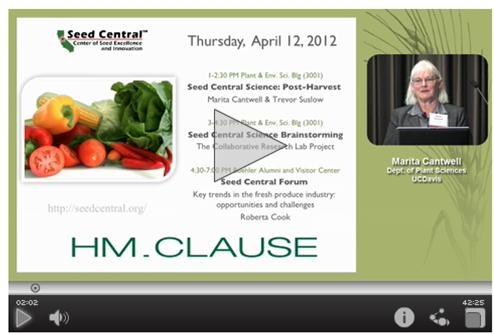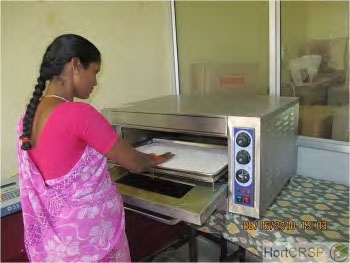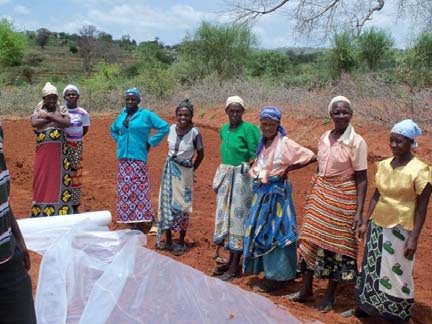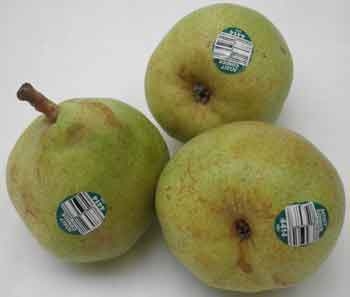Posts Tagged: Postharvest Technology Center
Feijoa - You can eat that?
I first tasted a feijoa (fay-zho-uh, or pineapple guava) as a student here at UC Davis many years ago. A friend showed me her secret trees (south side of Wellman in Davis — tons on the ground right now!), and I was hooked. I didn’t think much of it at the time, other than thinking this is one of the best things I have ever eaten in my life. It tastes better than candy, and ripens right around Halloween - sweet! I had never seen or heard of a feijoa. You likely haven’t either, so I’m writing to introduce you.
First a little history. This subtropical plant originated in the higher altitude regions of central South America, but has since been introduced and grown commercially in Europe, California, New Zealand, South Africa and the area around southern Russia. In California, Sutter and Yuba counties were the hot spot for growing pineapple guavas in the late 1980s. Farmers in that area, who benefitted from the kiwi expansion a few years before, enthusiastically jumped into the feijoa business, however did not realize the same success.
According to Adel Kader, UC Cooperative Extension specialist emeritus, "the nurseries that provided the trees were not accurate in identifying the different variety of trees, and there was a large difference in the taste.”
So a farmer had no idea if he had a good tree or not. Additionally, judging fruit maturity is difficult since the fruits do not significantly change color as they ripen and drop to the ground when they’re mature. So the optimal picking strategy is by “touch picking” where if you touch a fruit and, if it comes off the plant, it’s ready to eat. Imagine doing that for a whole orchard.
Back to the present. I rediscovered feijoas after riding my bike down our street before the green waste pick-up a couple years ago and noticed about 30 feijoas in my neighbor’s pick-up pile! They didn’t know you could eat them. So, yes, I picked them out of the pile and introduced my neighbors to the deliciousness of the pineapple guava. And then I promptly went out and bought myself a tree to plant in my own yard.
Feijoas taste like taking the best elements of strawberry, guava and pineapple and mixing them together. They smell pleasantly sweet and flowery. To eat a feijoa, cut (or rip) it in half and scoop out the inside creamy white flesh (a little brownish color is fine to eat). Feijoas are a good source of vitamin C, fiber and potassium, and they even contain a little protein.
So, where can you find feijoas? Well, if you're in Davis, visit the south side of Wellman. Or, you can plant your own tree like I did (you can reference the Postharvest Technology Center’s Produce Fact Sheet for Feijoas here), or you can go to your local farmers market. It’s a short season, so this is the weekend to search them out. When you find them, Kader suggests you “look for a larger fruit with a slight give and a nice aroma.” You won’t be disappointed.
It's just a waste, II
A year ago, a co-worker wrote a post on this blog entitled “It’s just a waste.” The sad facts of food waste are something we pay attention to since we work for the UC Postharvest Technology Center. A key component of our Center’s mission is to “reduce postharvest losses.” This topic also hits close to home on a personal level since I have always struggled with using up produce before it spoils. I go shopping about once a week, and tend to purchase just a bit more produce than what we will actually eat – in the hopes that one of us will suddenly adopt healthier eating habits by increasing our intake of fresh produce. I place the produce in my fruit ripening bowl, on the counter, or in the fridge, according to the recommendations on my handy produce storage chart. But nearly every week something goes awry, usually with my schedule, and I end up not serving the delicious produce-based meals I had planned, or I forget to pack my lunch, and oops, the negative effects of delayed consumption hit my produce.
The numbers show I’m not alone in this struggle, since research reports that nearly 30 percent of all produce losses in the United States happen at the consumer level. I was surprised to learn that today the average American consumer wastes nearly 50 percent more food than we did in the 1970s. (Link to the August 2012 Natural Resources Defense Council Report.) In the Food & Agriculture Organization of the United Nation's chart you can see that consumers from every other region around the world do significantly better than we in using their produce.
I want to do better, too! I hereby resolve to try harder to stick with my menu plan, pay closer attention to produce on the counter and the fridge (sometimes known affectionately in the produce industry as the “black hole”), and I will try very hard to be more creative in my use or preservation of quickly ripening produce.
My single biggest challenge is bananas. I try to buy a smaller hand of 5 to 6 bananas with some green tint left. They go on my banana hook in a cooler corner of my kitchen. At least half the weeks of the year those bananas have black spots within 3 to 4 days, and by day 5 there are usually 2 to 3 bananas left that are no longer appealing to my family. So almost half the bananas I buy usually don’t get eaten. I know, I know, “buy a smaller hand of bananas,” you say. That’s easier said than done, at least at the markets in which I shop.
Thankfully there are many cooks out there willing to share their recipes for creative ways to use up an over-supply of bananas. Below is a starting list of ideas that I’ll be drawing from as I make an effort to reduce produce waste, and especially banana waste, in our home.
- Slice into 1-inch chunks, freeze in a single layer on a wax paper covered cookie sheet. Transfer into a zip-bag and return to the freezer to use as needed for fruit smoothies or other cooking projects
- Banana bread or banana muffins
- Homemade banana ice cream
- Banana layer cake with cream cheese frosting
- Slice lengthwise, sauté in butter and ¼ tsp. rum flavoring until golden brown, and serve on ice cream
- Banana crunch cookies
- Make banana pancakes, add chocolate chips if desired (here’s a link to a pancake recipe called “Chunky Monkey” my son-in-law likes to make)
- Peel, insert a lollipop or popsicle stick and freeze. Eat as is, or dip in melted chocolate.
- Banana drop cookies
- Slice, dip in fresh lemon juice, and dry in a dehydrator
- Make a warm spiced banana topping that’s great on ice cream or gingerbread
- Banana oatmeal bar cookies
- Banana pudding
- Fruit Skewers
- Bananas Foster
- Banana Daiquiri
- Tropical banana bar cookies with raisins, pecans and coconut
- Banana cream pie
- Peanut butter, banana and rum bar cookies
- Trifle
- Burrito Bananas Foster
- Fruit Salad
- Banana crepes
- Dessert Pizza
- Banana Bundt cake with caramel frosting
- Fruit salsa, served with cinnamon tortilla chips
- Banana split
- Strawberry-banana parfait with yogurt and granola
Postharvest specialists share their expertise at 'Seed Central'
Aiming to energize the seed industry cluster surrounding UC Davis, Seed Central, an initiative of the Seed Biotechnology Center at UC Davis and SeedQuest, recently highlighted postharvest handling and food safety at their monthly forum. Recordings of invited guest speakers, Marita Cantwell, Trevor Suslow and Roberta Cook, UC Cooperative Extension specialists with expertise in post harvest science, show the passion they feel for their respective subjects and why we're fortunate to have them on our team. Cantwell and Suslow are in the UC Davis Department of Plant Sciences; Cook is in the UC Davis Department of Agricultural and Resource Economics.
Cantwell, a postharvest physiologist, specializes in handling and storage of intact and fresh-cut vegetables. In her talk, she describes the Postharvest Technology Center itself and gives an overview of the handling challenges of many vegetable varieties.
A plant pathologist, Suslow’s program centers on studying the effects of microflora on the postharvest quality of perishable produce. With much attention to current food safety a priority, Suslow’s produce safety overview and specific case examples help us all (ahem) digest this hot topic.
Cook, an agricultural economist, focuses on fresh produce marketing and food distribution. This presentation centers on North American vegetable markets. Even if you’re not a grower, shipper or retailer, Cook's description of trends in the produce industry are fascinating — we all eat fruits and vegetables every day. She talks about things we might not ever think about.
Addressing nutrition and poverty through horticulture
Nutrition, food security and sufficient family incomes are challenges in many parts of the world. Half the world’s people live in rural areas in developing countries. Because hunger and malnutrition are often linked to poverty, providing economic opportunities through horticultural production not only helps family incomes, but also addresses food security and nutrition. Training women to produce and market horticultural crops in the developing world also helps provide a much-needed income stream for families with children.
UC Davis is addressing food security and economic development in Africa, Southeast Asia, Central America, and elsewhere, by coordinating an international horticulture program. The Horticulture Collaborative Research Support Program (Hort CRSP; pronounced "hort crisp") is one of 10 CRSP programs that focus on global food production and solving food and nutrition problems in developing countries. UC Davis leads the Hort CRSP, with funding support from the U.S. Agency for International Development (USAID).
Examples of projects conducted by researchers and educators throughout the world include:
- Inexpensive cold storage systems in rural, developing areas to prolong food longevity; see page 2
- Concentrated solar drying of fruits and vegetables in East Africa; see page 3
- Improving safety and quality of tomatoes in Nigeria; see page 3
- Smallholder flower production in Honduras for export markets; see page 3
The overarching goals of the Hort CRSP are to reduce poverty and improve nutrition and health of the rural poor, while improving the profitability and sustainability of horticulture in the developing world. Priorities in the Hort CRSP include gender equity, sustainable crop production, postharvest technology, food safety, market access, and financing. The program awards research funding in the U.S. and abroad to:
- Realize opportunities for horticultural development
- Improve food security
- Improve nutrition and human health
- Provide opportunities for income diversification
- Advance economic and social conditions of the rural poor, particularly women
Dr. Elizabeth Mitcham, UC Cooperative Extension specialist in the Department of Plant Sciences at UC Davis and director of the Hort CRSP, notes, “By harnessing the research, training, and outreach expertise of the land-grant universities in the U.S. to work with partners in developing countries, we can improve horticultural capabilities in much the same way that the land-grant system helped revolutionize American agriculture.”
In the three years since the program’s inception, several projects have been completed, and many are ongoing. The program’s website offers a plethora of information, along with newsletters that highlight individual projects.
The program also has a YouTube channel, with videos on Hort CRSP projects. Some of the videos are about projects that are especially important in developing countries, including:
- The TRELLIS project — bringing together graduate students and in-country development organizations; YouTube link
- Using cell phones to give real-time information to growers in rural areas of India; YouTube link
- Inexpensive cultivation practices for smallholder farmers; YouTube link
- Indigenous products increase incomes in Ghana; YouTube link
- Saving indigenous crop seeds in Southeast Asia for resource-poor farmers; YouTube link
UC Davis, ranked first in the U.S. on research related to agriculture, food science and nutrition, and plant and animal science, is positioned to serve global needs related to food and nutrition. Of the 10 CRSP programs administered by USAID, two of the programs are based at UC Davis — the Hort CRSP program, and the BASIS CRSP, which was highlighted in a recent Food Blog post and addresses financial issues related to agricultural productivity.
California's delicious harvest season unfolds
Early spring can be an invigorating time of year, with lengthening days, blooming daffodils and fruit trees (and ski season still in full force). One of the best perks of the season is the availability of luscious strawberries, and tasty artichokes and asparagus picked from nearby farms, with flavor quality and price that reflects both in-season and local transportation benefits.
Depending on your location, farmers markets and pick-your-own farms will begin offering their wares within the next month or two. There are over 700 farmers markets in California. A wide variety of produce, from the exotic to the humble every-day variety, is available to entice you with its fresh beauty. We here in the West spend more annually on fresh produce at $511 vs. the national average of $429, wrote Roberta Cook, UC Cooperative Extension specialist in the UC Davis Department of Agriculture and Resource Economics, in “Eye on Economics: Much more than Dollars and Cents. Cook states that, “California produces half of the nation’s fresh fruits and vegetables and consumers here are privileged to have an abundance of high quality fresh produce over extended seasons due to California’s Mediterranean climate.”
Elsewhere in the United States “local” food markets are much less developed due to climate restrictions that limit production to a brief period in the summer and early fall; and the variety of products grown is only a fraction of the over 200 crops grown in California. While “local” production represents a rapidly growing share of U.S. agricultural sales, with direct-to-consumer sales more than quadrupling in the past decade, outside of California the share is still tiny.
There are few things as disappointing as biting into a piece of fruit that looks beautiful on the outside but just doesn’t deliver that burst of flavor, or cutting into a nice-looking vegetable only to find an unsightly defect inside. When I’m prowling through a display of fresh produce, I rev up all my senses into high gear and get up-close and personal with the fruit and veggie items on my list. I get busy feeling the weight-to-size ratio, gently (not too hard, mind you, or you’ll get a bad reputation with other shoppers) pressing to feel for firmness, looking at color, form, and stem separation area, and smelling the aroma. All of these things, and more, help provide clues about the quality inside.
Country of Origin Labeling (COOL) and Price Look Up (PLU) stickers
Other clues are often available about where and how your produce items were grown. For instance, in 2009 rules (affecting retail grocers) were adopted by the USDA mandating country of origin labeling (COOL), which required that retailers notify customers of the country of origin of all perishable agricultural commodities. Also offering insights into your produce selection is the Price Look Up sticker. Created by the Produce Marketing Association (PMA) in 1987 to create a standardized system to assist check-out clerks with looking up the produce items, it also indicates additional information such as whether it’s organic.
For instance, if your produce item’s sticker has a 4 digit code, it is “conventionally grown, but not organic.” If the code has 5 digits, and the first digit is a 9, the produce was organically grown. Usually the PLU stickers also include the country of origin in writing, but if not, this information should be displayed on the packing box or other store signage. Conventionally grown produce is recognized by scientists and regulators to be just as safe as organically grown and there is no evidence that it is worse for the environment. About 95 percent of retail fresh produce sales are conventionally grown and generally cost about 30 percent less than organics.
There are a number of resources that can help produce shoppers improve their savvy shopping skills:
From the Farm to Your Table: A Consumer’s Guide to Fresh Fruits and Vegetables, by James Thompson and Adel Kader. This 16-page booklet offers information on measuring quality; farm-based growing conditions, practices and harvesting; handling, transportation and storage; and selecting and storing good-quality produce for use at home. The table on how to select good-quality produce is especially helpful. ($7.00/copy)
Shopping for Fruits & Vegetables at the Fruits and Veggies: More Matters web site
Storing Fresh Fruit and Vegetables for Better Taste, a free downloadable poster from the UC Davis Postharvest Technology Center
i know produce, a comprehensive produce website developed by the Produce Marketing Association (PMA) that includes photo identification, written description, availability by location, nutrition information, storage/handling, and tips.



